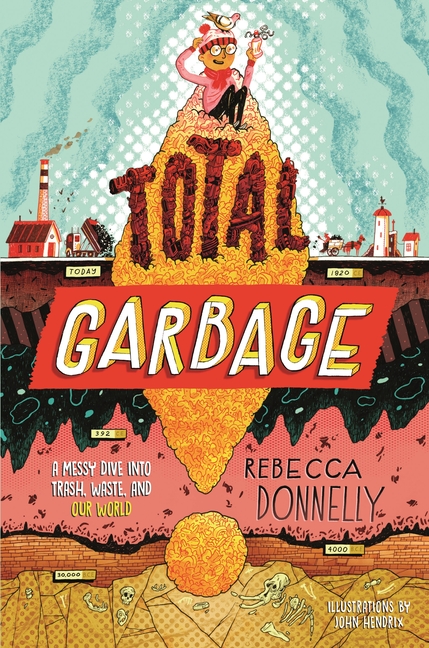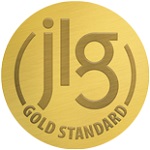
Book Resume
for Total Garbage by Rebecca Donnelly and John Hendrix
Professional book information and credentials for Total Garbage.
7 Professional Reviews (2 Starred)
3 Book Awards
Selected for 2 State/Province Lists
See full Book Resume
on TeachingBooks
An eye-opening, occasionally gross, and above all fascinating account explores what ...read more
- Publisher's Weekly:
- Ages 8 - 12
- Booklist:
- Grades 5 - 8
- School Library Journal:
- Grades 4 - 8
- Kirkus:
- Ages 10 - 14
- TeachingBooks:*
- Grades 5-8
- Lexile Level:
- 1140L
- Genre:
- Nonfiction
- Year Published:
- 2023
3 Subject Headings
The following 3 subject headings were determined by the U.S. Library of Congress and the Book Industry Study Group (BISAC) to reveal themes from the content of this book (Total Garbage).
7 Full Professional Reviews (2 Starred)
The following unabridged reviews are made available under license from their respective rights holders and publishers. Reviews may be used for educational purposes consistent with the fair use doctrine in your jurisdiction, and may not be reproduced or repurposed without permission from the rights holders.
Note: This section may include reviews for related titles (e.g., same author, series, or related edition).
From Cooperative Children's Book Center (CCBC)
An eye-opening, occasionally gross, and above all fascinating account explores what we do with the things we no longer want or need. Chapters titled “What Is Trash?”, “Where Does Our Garbage Come From?”, “Why Do We Make So Much Garbage?”, “Where Does Our Garbage Go?”, “What Can We Learn from Our Garbage?”, and “How Can We Do Better?” explore various kinds of waste; the waste stream, which exists for both an item’s production (upstream) and post-use (downstream); and options for what we can (and can’t) do with various kinds of waste; as well as some intriguing history. The absence of a table of contents is unfortunate, but the engaging narrative invites thoughtful consideration of the individual and collective impact of our choices and the cause-and-effect relationship humans have with garbage. A “Trash Timeline,” selected resources, and index are included in the back matter of a volume that is pure trash—in the best way possible. (Ages 9–14)
CCBC Choices 2024 © Cooperative Children's Book Center, Univ. of Wisconsin - Madison, 2024. Used with permission.
From Horn Book
Starred review from May 1, 2023
In this accessible overview of garbage, Donnelly's trash talk supports an appealing conversational narrative. She asks readers to examine five questions, each addressed in its own chapter: "What is garbage, where does it come from, where does it go, why do we make so much of it, and how can we do better?" Rather than assuming the tone of an all-knowing narrator, Donnelly uses the first-person-plural we (e.g., "We make a lot of trash") and direct address, inviting readers to be partners in understanding and seeking solutions to this global issue. Hendrix's occasional spot art emphasizes the light tone, accentuating but never undermining the narrative. Donnelly presents pertinent comparisons; for example, in 2018 Americans produced 292 million tons of trash -- or what 5,600 Titanic-sized ships would weigh. And she reminds us that when we throw something away, it really doesn't go away. This thorough and thoughtful treatment allows readers to understand the many complicated issues and possibly generate their own individual solutions. Here, Donnelly has turned trash into treasure. Appended with an author's note, a waste management timeline, print and electronic resources, and an (unseen) index. Betty Carter
(Copyright 2023 by The Horn Book, Incorporated, Boston. All rights reserved.)
From Publisher's Weekly
April 3, 2023
In seven chapters, Donnelly talks trash, addressing questions including "Where does our garbage come from?"; "Why do we make so much garbage?"; and "What can we learn from our garbage?" The bookâ€"filled with statistics from before 2020â€"touches on the usual topics, but also on archeology, contemporary art, environmental racism, history, upcycling and downcycling, and corporate efforts to keep consumers buying and using plastic. "If you look hard enough, you'll find money at the root of most of our waste problems," reads one characteristically incisive takeaway. Occasional line drawings from Hendrix, cast in teal, break up the text and lighten the mood with gentle humor. Despite the seriousness of the world's garbage predicament, the text's message remains one of encouragement, offering creative examples of different communities' solutions and urging readers not to give up hope. Ages 8â€"12.
From Booklist
March 1, 2023
Grades 5-8 Readers will need strong stomachs for some of the nauseating facts Donnelly dishes in her deep dumpster dive, but they'll emerge a heartier lot that's armed with awareness and the tools to clean up their acts, environmentally speaking. This guide to garbage takes a rounded approach to its topic, offering readers eye-opening statistics and facts about the world's waste problem along with a dash of science and historical and social contexts. Donnelly's engaging tone and Hendrix's cartoon spot art lend a welcome breeziness to an otherwise malodorous affair. As can be expected, the book tackles what we're throwing away, where it goes, and what happens once it reaches its destination, whether landfill, incinerator, recycling center, or compost heap. What readers might not expect to encounter are fatbergs, "wish-cycling," fast fashion, environmental justice, and the U.S. habit of shipping our waste to poorer countries. It's a lot to take in, but not all of it stinks, as Donnelly offers readers solid advice on reducing and responsibly disposing of their trash while maintaining hope for a cleaner future.
COPYRIGHT(2023) Booklist, ALL RIGHTS RESERVED.
From School Library Journal
February 1, 2023
Gr 4-8-Donnelly explores where trash comes from, who is responsible for it, the environmental and health implications and consequences of garbage, and how we can cut down on it. Our dependence on synthetic, mass-produced materials like plastic and stainless steel is presented in stark contrast to the trash accumulated hundreds of years ago when garbage came from discarded handmade, organic materials. The existence of rag-and-doll men, waste pickers, and mud larks, gave trash a second life while helping those less fortunate make a living pre-Industrial Revolution. Presently, Americans throw out almost 300 tons of garbage a year, but even though it's out of sight out of mind for many, waste does not disappear. The author's accessible text is informative and straightforward but never judgmental. The matter-of-fact narrative makes a seemingly nasty subject fascinating and even palatable. Terms like municipal solid waste, planned obsolescence, and compost and anaerobic digestion are explained in a kid-friendly way. Hendrix's humorous and genuine line drawings add levity to the subject but keep things accurate. The design includes chapter openers and teal font and illustrations, which will instantly draw in reluctant readers. An index is included; other back matter was not seen at the time of review. VERDICT Incredibly, this book makes garbage fun to read about and is a great choice for browsable nonfiction shelves and curricular tie-ins.-Shelley M. Diaz
Copyright 2023 School Library Journal, LLC Used with permission.
From Kirkus
Starred review from January 15, 2023
A study of trash, past, present, and future. Brief descriptions of a "trash museum" and a library of discarded books introduce this entertaining but hard-hitting look at what we toss, where it goes, and how we can do better. Focusing throughout on Europe and the Americas, Donnelly misses the chance to compare 19th-century U.S. "waste-pickers" to children picking trash today in India or South Africa. But she produces mounds of data, makes connections to various cultures throughout history, art, and archaeology, and raises crucial questions about environmental values, capitalism and profit motives, and the future. Making the topic personal, Donnelly addresses readers directly. Depressing statistics and sections discussing the consequences of irresponsibly disposing of waste, as well as environmental justice and racism (people of color and impoverished communities are disproportionately affected by issues with garbage), are gloomy, but Donnelly's clear, engaging writing also lights up the many pages on health, science, and human behavior, on positive actions that families and communities can take, and on industrial responsibility (but none on U.S. government regulatory authority or fossil fuel subsidies). Whimsical, informative, detailed teal-tone line drawings add to a captivating and important book. A fact-filled and fascinating dumpster dive of a book. (author's note, timeline, selected resources) (Nonfiction. 10-14)
COPYRIGHT(2023) Kirkus Reviews, ALL RIGHTS RESERVED.
From Horn Book
January 1, 2023
In this accessible overview of garbage, Donnelly's trash talk supports an appealing conversational narrative. She asks readers to examine five questions, each addressed in its own chapter: "What is garbage, where does it come from, where does it go, why do we make so much of it, and how can we do better?" Rather than assuming the tone of an all-knowing narrator, Donnelly uses the first-person-plural we (e.g., "We make a lot of trash") and direct address, inviting readers to be partners in understanding and seeking solutions to this global issue. Hendrix's occasional spot art emphasizes the light tone, accentuating but never undermining the narrative. Donnelly presents pertinent comparisons; for example, in 2018 Americans produced 292 million tons of trash -- or what 5,600 Titanic-sized ships would weigh. And she reminds us that when we throw something away, it really doesn't go away. This thorough and thoughtful treatment allows readers to understand the many complicated issues and possibly generate their own individual solutions. Here, Donnelly has turned trash into treasure. Appended with an author's note, a waste management timeline, print and electronic resources, and an (unseen) index.
(Copyright 2023 by The Horn Book, Incorporated, Boston. All rights reserved.)
3 Book Awards & Distinctions
Total Garbage was recognized by committees of professional librarians and educators for the following book awards and distinctions.
2 Selections for State & Provincial Recommended Reading Lists
Total Garbage was selected by educational and library professionals to be included on the following state/provincial reading lists.
United States Lists (2)
Preview Digital Book
Explore Total Garbage on Marketplace. Access requires OverDrive Marketplace login.
This Book Resume for Total Garbage is compiled from TeachingBooks, a library of professional resources about children's and young adult books. This page may be shared for educational purposes and must include copyright information. Reviews are made available under license from their respective rights holders and publishers.
*Grade levels are determined by certified librarians utilizing editorial reviews and additional materials. Relevant age ranges vary depending on the learner, the setting, and the intended purpose of a book.
Retrieved from TeachingBooks on January 19, 2025. © 2001-2025 TeachingBooks.net, LLC. All rights reserved by rights holders.


 CCBC Choices, Selection, 2024
CCBC Choices, Selection, 2024
 Junior Library Guild Selections, 2012-2024, Series Nonfiction Selection, 2023
Junior Library Guild Selections, 2012-2024, Series Nonfiction Selection, 2023
 SLJ Best Books of the Year, 2010 - 2024, Selection, 2023
SLJ Best Books of the Year, 2010 - 2024, Selection, 2023
